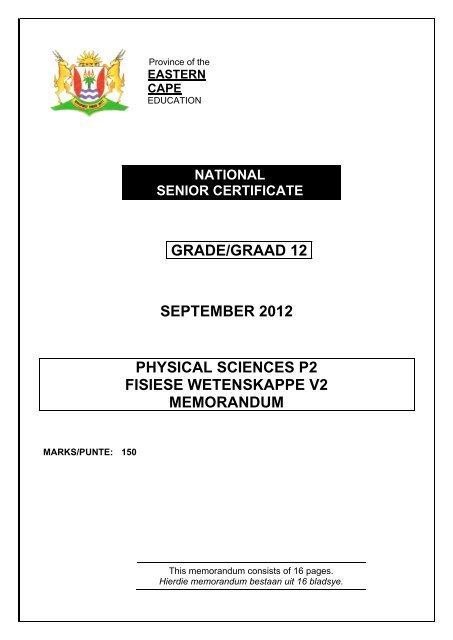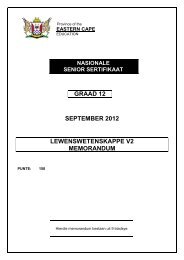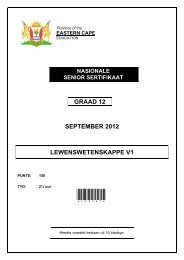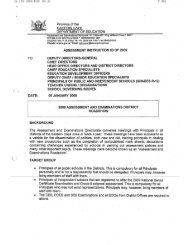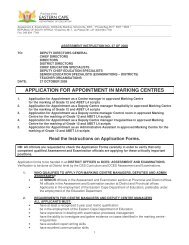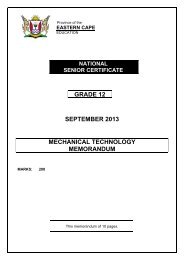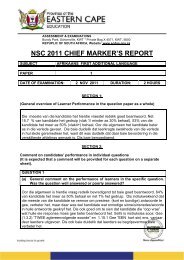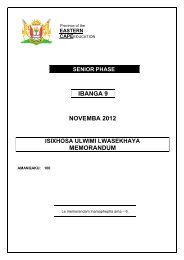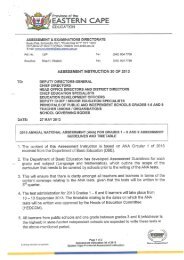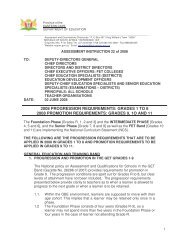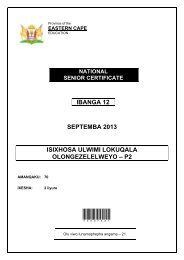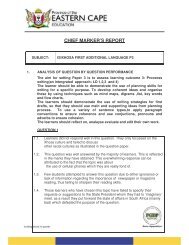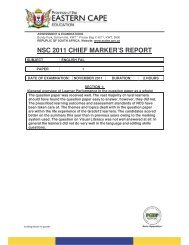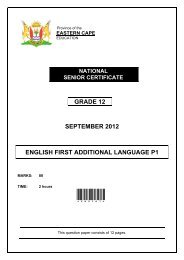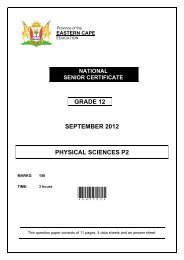grade/graad 12 september 2012 physical sciences p2 fisiese ...
grade/graad 12 september 2012 physical sciences p2 fisiese ...
grade/graad 12 september 2012 physical sciences p2 fisiese ...
Create successful ePaper yourself
Turn your PDF publications into a flip-book with our unique Google optimized e-Paper software.
(SEPTEMBER 20<strong>12</strong>) FISIESE WETENSKAPPE V2 (Memo) 3AS <strong>12</strong>.1.3Apply known problemsolvingstrategies to solvemulti-step problems.Pas bekendeprobleemoplossingstrategieëtoe omveelvuldigestapprobleme opte los.AS <strong>12</strong>.1.4Communicate and presentscientific arguments withclarity and precision.Kommunikeer en verdedigwetenskaplike argumentduidelik en presies.AS <strong>12</strong>.2.3Apply scientific knowledgein everyday life contexts.Pas wetenskaplike kennisin kontekste van diealledaagse lewe toe.AS <strong>12</strong>.3.3Evaluate the impact ofscientific and technologicalknowledge on sustainabledevelopment of resources andsuggest long-term and shorttermstrategies to improve themanagement of resources inthe environment.Evalueer die impak vanwetenskaplike en tegnologiesekennis op volhoubareontwikkeling van bronne enom kort-termyn en lang-termynstrategieë voor te stel om diebestuur van bronne in dieomgewing te verbeter.GUIDELINES FOR MARKING/RIGLYNE VIR NASIENThis section provides guidelines for the way in which marks will be allocated. Thebroad principles must be adhered to in the marking of Physical Sciences tests andexaminations.Hierdie afdeling verskaf riglyne vir die manier waarop punte toegeken sal word.Die breë beginsels moet tydens die nasien van Fisiese Wetenskappe toetse eneksamens gevolg word.1.1 MARK ALLOCATION/PUNTE TOEKENNING1.1.1 Definitions/Definisies:Two marks will be awarded for a correct definition. No marks willbe awarded for an incorrect or partially correct definition.Twee punte sal vir ʼn korrekte definisie toegeken word. Geen puntesal vir ʼn verkeerde of gedeeltelik korrekte definisie toegeken wordnie.1.1.2 Calculations/Berekeninge:o Marks will awarded for: correct formula, correct substitution,correct answer with unit.Punte sal toegeken word vir: korrekte formule, korrektesubstitusie, korrekte antwoord met eenheid.o No marks will be awarded if an incorrect or inappropriateformula is used, even though there may be relevant symbolsand applicable substitutions.o Geen punte sal toegeken word waar ʼn verkeerde ofontoepaslike formule gebruik word nie, selfs al is daarrelevante simbole en relevante substitusies.
4 PHYSICAL SCIENCES P2 (Memo) (SEPTEMBER 20<strong>12</strong>)1.1.3 Explanations and interpretations/Verduidelikings eninterpretasie:Allocation of marks to questions requiring interpretation orexplanation e.g. AS 1.4, 2.2, 2.3, 3.1, 3.2 and 3.3, will differ andmay include the use of rubrics, checklists, memoranda, etc. In allsuch answers emphasis must be placed on scientific conceptsrelating to the question.Toekenning van punte by vrae wat interpretasie of verduidelikingvereis bv. AS 1.4, 2.2, 2.3, 3.1, 3.2 en 3.3, sal verskil en mag diegebruik van rubrieke, kontrolelyste, memoranda, ens. insluit. By alhierdie antwoorde moet die beklemtoning op die wetenskaplikekonsepte, met betrekking tot die vraag, val.1.2 FORMULAE AND SUBSTITUTIONS/FORMULES EN SUBSTITUSIE1.2.1 Mathematical manipulations and change of subjects of appropriateformulae carry no marks, but if a candidate starts with the correctformula and then changes the subject of the formula incorrectly,marks will be awarded for the formula and the correct substitutions.The mark for the incorrect numerical answer is forfeited.Wiskundige manipulering en verandering van die voorwerp vantoepaslike formules dra geen punte nie, maar as ʼn kandidaat beginmet die korrekte formule en dan die voorwerp van die formuleverkeerd uitwerk, sal punte vir die formule en korrekte substitusietoegeken word.1.2.2 When an error is made during substitution into a correctformula, a mark will be awarded for the correct formula and for thecorrect substitutions, but no further marks will be given.Wanneer ʼn fout gedurende substitusie in ʼn korrekte formulebegaan word, sal ʼn punt vir die korrekte formule en vir korrektesubstitusie toegeken word, maar geen verdere punte saltoegeken word nie.1.2.3 Marks are only awarded for a formula if a calculation had beenattempted, i.e. substitutions have been made or a numericalanswer given.Punte sal slegs toegeken word vir ʼn formule as ʼn pogingaangewend was om ʼn berekening te doen d.w.s. substitusie wasgedoen of ʼn numerieke antwoord word verskaf.1.2.4 Marks can only be allocated for substitutions when values aresubstituted into formulae and not when listed before a calculationstarts.Punte kan slegs toegeken word vir substitusies wanneer waardesin formules ingestel is en nie vir waardes wat voor ʼn berekeninggelys is nie.1.2.5 All calculations, when not specified in the question, must be doneto two decimal places.Alle berekenings, wanneer nie in die vraag gespesifiseer word nie,moet tot twee desimale plekke gedoen word.
(SEPTEMBER 20<strong>12</strong>) FISIESE WETENSKAPPE V2 (Memo) 51.3 UNITS/EENHEDE1.3.1 Candidates will only be penalised once for the repeated use of anincorrect unit within a question or sub-question.ʼn Kandidaat sal slegs een keer gepenaliseer word vir dieherhaaldelike gebruik van ʼn verkeerde eenheid in ʼn vraag ofsubvraag.1.3.2 Units are only required in the final answer to a calculation.Eenhede word slegs in die finale antwoord tot ʼn vraag verlang.1.3.3 Marks are only awarded for an answer, and not for a unit per se.Candidates will therefore forfeit the mark allocated for the answerin each of the following situations:correct answer + wrong unitwrong answer + correct unitcorrect answer + no unit.Punte word slegs vir ʼn antwoord en vir ʼn eenheid per se toegekennie. Kandidate sal derhalwe die punt vir die antwoord in dievolgende gevalle verbeur:korrekte antwoord + verkeerde eenheidverkeerde antwoord + korrekte eenheidkorrekte antwoord + geen eenheid1.3.4 SI units must be used except in certain cases, e.g. V . m -1 instead ofN . C -1 , and cm . s -1 or km . h -1 instead of m . s -1 where the questionwarrants this. (This instruction only applies to Paper 1).SI-eenhede moet gebruik word behalwe in sekere gevalle, bv.V . m -1 in plaas van of N . C -1 , en cm . s -1 of km . h -1 in plaas van m . s -1waar die vraag dit verlang. (Hierdie instruksie geld slegs byVraestel 1).
6 PHYSICAL SCIENCES P2 (Memo) (SEPTEMBER 20<strong>12</strong>)1.4 POSTIVE MARKING/POSITIEWE NASIENPositive marking regarding calculations will be followed in the followingcases:Positiewe nasien met betrekking tot berekeninge sal in die volgendegevalle geld:1.4.1 Sub-question to sub-question: When a certain variable iscalculated in one sub-question (e.g. 3.1) and needs to besubstituted in another (3.2 or 3.3), e.g. if the answer for 3.1 isincorrect and is substituted correctly in 3.2 or 3.3, full marks are tobe awarded for the subsequent sub-questions.Subvraag na subvraag: Wanneer ʼn sekere veranderlike in eensubvraag (bv. 3.1) bereken word en dan in ʼn ander vervang moetword (3.2 of 3.3), bv. Indien die antwoord vir 3.1 verkeerd is enword korrek in 3.2 of 3.3 vervang, word volpunte aan diedaaropvolgende subvraag toegeken.1.4.2 A multi-step question in a sub-question: If the candidate has tocalculate, for example, current in the first step and gets it wrongdue to a substitution error, the mark for the substitution and thefinal answer will be forfeited.ʼn Vraag met veelvuldige stappe in ʼn subvraag: Indien ʼnkandidaat byvoorbeeld, die aantal mol verkeerd bereken in ʼneerste stap as gevolg van ʼn substitusiefout, verloor die kandidaatdie punt vir die substitusie sowel as die finale antwoord.1.4.3 If a final answer to a calculation is correct, full marks will notautomatically be awarded. Markers will always ensure that thecorrect/appropriate formula is used and that workings, includingsubstitutions, are correct.Indien ʼn finale antwoord tot ʼn berekening korrek is, sal volpunte nieoutomaties toegeken word nie. Nasieners sal altyd verseker dat diekorrekte toepaslike formule gebruik word en dat bewerkings,insluitende substitusies korrek is.1.4.4 Questions where a series of calculations have to be made (e.g. acircuit diagram question) do not necessarily always have to followthe same order. FULL MARKS will be awarded provided it is a validsolution to the problem. However, any calculation that will not bringthe candidate closer to the answer than the original data, will notcount any marks.Vrae waar ʼn reeks berekeninge gedoen moet word (bv. ʼnstroombaan diagram vraag) hoef nie noodwendig altyd dieselfdeorde te volg nie. VOLPUNTE sal toegeken word mits dit ʼn geldigeoplossing tot die probleem is. Maar, enige berekening wat nie diekandidaat nader aan die antwoord bring as die oorspronklike data,sal geen punte tel nie.
(SEPTEMBER 20<strong>12</strong>) FISIESE WETENSKAPPE V2 (Memo) 71.4.5 If one answer or calculation is required, but two given by thecandidate, only the first one will be marked, irrespective of whichone is correct. If two answers are required, only the first two will bemarked, etc.Indien een antwoord of berekening verlang word, maar twee worddeur die kandidaat gegee, sal slegs die eerste een nagesien word,ongeag watter een korrek is. Indien twee antwoorde verlang word,sal slegs die eerste twee nagesien word, ens.1.4.6 Normally, if based on a conceptual mistake, an incorrect answercannot be correctly motivated. If the candidate is therefore requiredto motivate in question 3.2 the answer given to question 3.1, and3.1 is incorrect, no marks can be awarded for question 3.2.However, if the answer for e.g. 3.1 is based on a calculation, themotivation for the incorrect answer for 3.2 could be considered.Normaalweg, as dit gebaseer is op ʼn voorstellingsfout, kan ʼnverkeerde antwoord nie korrek gemotiveer word nie. As diekandidaat derhalwe gevra word met ʼn vraag in 3.2 om dieantwoord in vraag 3.1 te motiveer, en 3.1 is verkeerd, sal geenpunte vir vraag 3.2 toegeken word nie. Maar, as die antwoord in bv.3.1 gebaseer is op ʼn berekening, kan die motivering vir dieverkeerde antwoord oorweeg word.1.4.7 If instructions regarding method of answering are not followed, e.g.the candidate does a calculation when the instruction was to solveby construction and measurement, a candidate may forfeit allthe marks for the specific question.Indien instruksies aangaande metode van beantwoording niegevolg word nie, bv. die kandidaat doen ʼn berekening wanneer dieinstruksie los op deur konstruksie en meting was, mag diekandidaat al die punte vir die spesifieke vraag verbeur.1.4.8 For an error of principle, no marks are awarded (Rule 1) e.g. Ifthe potential difference is 200 V and resistance is 25 Ω, calculatethe current.Vir ʼn voutdraendebeginsel, sal geen punte toegeken word nie(Reël 1) bv. As die potensiaalverskil 200 V en die weerstand 25 Ωis, bereken die stroom.CORRECT/KORREKANSWER (1)ANTW (1)POSSIBLEMOONTLIKANSWER (2)ANTW (2)POSSIBLEMOONTLIK
8 PHYSICAL SCIENCES P2 (Memo) (SEPTEMBER 20<strong>12</strong>)1.5 GENERAL PRINCIPLES OF MARKING IN CHEMISTRY/ALGEMENE BEGINSELS VAN NASIEN BY CHEMIEThe following are a number of guidelines that specifically apply to Paper 2.Die volgende is ʼn aantal riglyne wat spesifiek met Vraestel 2 vantoepassing is.1.5.1 When a chemical FORMULA is asked, and the NAME is given asanswer, only one of the two marks will be awarded. The same ruleapplies when the NAME is asked and the FORMULA is given.Wanneer ʼn chemiese FORMULE gevra word en die NAAM wordas antwoord gegee, sal slegs een van die twee punte toegekenword. Dieselfde reël geld wanneer die NAAM gevra word en dieFORMULE gegee word.1.5.2 When redox half-reactions are to be written, the correct arrowshould be used. If the equationH 2 S → S + 2H + + 2e - ( 2 / 2 )is the correct answer, the following marks will be given:Wanneer redokshalfreaksies geskryf moet word, moet die korrektepyltjie gebruik word. Indien die bostaande vergelyking die korrekteantwoord is, sal die volgende punte toegeken word:H 2 S ⇋ S + 2H + + 2e - ( 1 / 2 )H 2 S ← S + 2H + + 2e - ( 0 / 2 )S + 2H + + 2e - ← H 2 S ( 2 / 2 )S + 2H + + 2e - ⇋ H 2 S ( 0 / 2 )1.5.3 When candidates are required to give an explanation involving therelative strength of oxidising and reducing agents, the following isunacceptable:Stating the position of a substance on Table 4 only (e.g. Cuis above Mg).Using relative reactivity only (e.g. Mg is more reactive thanCu).The correct answer would for instance be: Mg is a strongerreducing agent than Cu, and therefore Mg will be able toreduce Cu 2+ ions to Cu. The answer can also be given interms of the relative strength as electron acceptors anddonors.Wanneer kandidate ʼn verduideliking moet gee oor die relatiewesterkte van oksideer- en reduseermiddels, is die volgendeonaanvaarbaar.Meld slegs die posisie van ʼn stof op tabel 4 (bv. Cu is boMg).Gebruik slegs relatiewe reaktiwiteit (bv. Mg is meer reaktiefas Cu).Die korrekte antwoord sal byvoorbeeld wees: Mg is ʼn sterkerreduseermiddel as Cu en derhalwe sal Mg in staat wees omCu 2+ -ione na Cu te reduseer. Die antwoord kan ook in termevan die relatiewe sterkte van elektronakseptors of donorsgegee word.
(SEPTEMBER 20<strong>12</strong>) FISIESE WETENSKAPPE V2 (Memo) 91.5.4 One mark will be forfeited when the charge of an ion is omitted perequation.Een punt sal verbeur word wanneer die lading van ʼn ioon pervergelyking weggelaat is.1.5.5 The error carrying principle does not apply to chemical equations orhalf-reactions. For example, if a learner writes the wrongoxidation/reduction half-reaction in the sub-question and carries theanswer to another sub-question (balancing of equations orcalculations of E θ cell) then the learner is not credited for thissubstitution.Die foutdraendebeginsel geld nie vir chemiese vergelykings ofhalfreaksies nie. Byvoorbeeld, indien ʼn leerder die verkeerdeoksidasie/reduksie-halfreaksie vir die subvraag skryf en dieantwoord na ʼn ander subvraag dra (balansering van vergelyking ofE sel ) dan word die leerder nie vir die substitusie gekrediteer nie.1.5.6 When a calculation of the cell potential of a galvanic cell isexpected, marks will only be awarded for the formula if one of theformulae indicated on the data sheet (Table 2) is used. The use ofany other formula using abbreviations etc. will carry no marks.Wanneer ʼn berekening van die selpotensiaal van ʼn galvanieseselverlang word, sal punte slegs vir die formule toegeken word as eenvan die formules op die gegewensblad (Tabel 2) gebruik word. Diegebruik van enige ander formule, die gebruik van afkortings, ens.Sal geen punte dra nie.1.5.7 In the structural formula of an organic molecule all hydrogen atomsmust be shown. Marks will be deducted if hydrogen atoms areomitted.In die struktuurformules van ʼn organiese molekuul moet allewaterstofatome getoon word. Punte sal afgetrek word vir dieweglating van waterstofatome.1.5.8 When a structural formula is asked, marks will be deducted if thecandidate writes the condensed formula.Wanneer ʼn struktuurformule gevra word, sal punte afgetrek wordindien die leerder die gekondenseerde formule skryf.1.5.9 When an IUPAC name is asked, and the candidate omits thehyphen (e.g. instead of 1-pentene the candidate writes 1 pentene),marks will be forfeited.Wanneer die IUPAC naam gevra word en die koppelteken(s) in dienaam word uitgelaat (bv. In plaas van pent-1-een of 1-penteenskryf ʼn kandidaat pent 1 een of 1 penteen), sal punte verbeur word.
10 PHYSICAL SCIENCES P2 (Memo) (SEPTEMBER 20<strong>12</strong>)SECTION/AFDELING AQUESTION/VRAAG 11.1 Stereo-isomers/stereoïsomere [<strong>12</strong>.2.1] (1)1.2 Effective collisions/effektiewe botsings [<strong>12</strong>.2.1] (1)1.3 Oxidising agent/reducedsubstance/Oksideermiddel/gereduseerde stof [<strong>12</strong>.2.1] (1)1.4 Sodium hydroxide/natriumhidroksied [<strong>12</strong>.2.1] (1)1.5 Haber process/Haberproses [<strong>12</strong>.2.1] (1)[5]QUESTION/VRAAG 22.1 A [<strong>12</strong>.2.1] (2)2.2 B [<strong>12</strong>.2.1] (2)2.3 D [<strong>12</strong>.2.3] (2)2.4 B [<strong>12</strong>.2.3] (2)2.5 C [<strong>12</strong>.2.3] (2)2.6 B [<strong>12</strong>.2.3] (2)2.7 C [<strong>12</strong>.2.3] (2)2.8 A [<strong>12</strong>.2.1] (2)2.9 A [<strong>12</strong>.2.3] (2)2.10 C [<strong>12</strong>.2.3] (2)[20]TOTAL SECTION/TOTAAL AFDELING A: 25
(SEPTEMBER 20<strong>12</strong>) FISIESE WETENSKAPPE V2 (Memo) 11SECTION/AFDELING BQUESTION/VRAAG 33.1 H OH C C O H H [<strong>12</strong>.2.3] (2)3.2 carboxylic acids/karboksielsure [<strong>12</strong>.2.1] (1)3.3 CH 3 CH 2 OH + O 2 → CH 3 COOH + H 2 O ( Bal) [<strong>12</strong>.2.3] (3)3.4 Fermentation/gistingsproses/fermentasie [<strong>12</strong>.2.3] (2)[8]QUESTION/VRAAG 44.1 4.1.1 H H HC = C C C H 1-butene/but-1-ene1-buteen/but-1-een H H H H[<strong>12</strong>.2.3] (3)4.1.2 Elimination/dehydrohalogenation/Eliminasie/dehidrohalogenasie [<strong>12</strong>.2.3] (2)4.1.3 H Cl H H4.2 4.2.1 OH C C C C H H H H H [<strong>12</strong>.2.3] (2)R C O R I [<strong>12</strong>.2.3] (2)4.2.2 alcohols and carboxylic acids/alkohole en karboksielsure [<strong>12</strong>.2.3] (2)4.2.3 pineapple/pynappel [<strong>12</strong>.2.1] (1)[<strong>12</strong>]
<strong>12</strong> PHYSICAL SCIENCES P2 (Memo) (SEPTEMBER 20<strong>12</strong>)QUESTION/VRAAG 55.1 Compounds which contain only H- and C- atoms./Verbindings wat slegs uit H- en C-atome bestaan. [<strong>12</strong>.2.1] (2)5.2 Saturated hydrocarbons/versadigde koolwaterstowwe No further atoms can be added to the molecule/Has only singlebonds /Geen verdere atome kan by die molekuul gevoeg word nie/Hetslegs enkelbindings. [<strong>12</strong>.1.4] (3)5.3 Gas [<strong>12</strong>.2.1] (1)5.4 C n H 2n+2 [<strong>12</strong>.2.1] (1)5.5 C n H 2n+2 [<strong>12</strong>.1.2] (2)5.6 The longer the alkane chain/the greater the number of C-atoms,the greater the intermolecular forces and the higher the boilingpoint. /Hoe langer die alkaanketting/hoe groter die aantal C-atome,hoegroter die intermolekulêre kragte en hoe hoër die kookpunt. [<strong>12</strong>.1.4] (2)5.7 The size of the molecule/surface area/molecular mass increaseswith more C-atoms. The larger the molecule, the more van derWaal’s forces are formed. More van der Waal’s forces requiremore energy to overcome these forces, therefore the higher theboiling points. /Die grootte/oppervlakte/molekulêre massa van die molekulevergroot met ʼn groter aantal C-atome. Hoe groter die molekuul,hoe meer van der Waalskragte wat kan vorm. Meer van derWaalskragte het meer energie nodig om die kragte te oorkom dus styg die kookpunte. [<strong>12</strong>.1.4] (4)5.8 H H HH C C C H H HH C HH [<strong>12</strong>.2.3] (2)5.9 2-methylpropane/2-metielpropaan [<strong>12</strong>.2.3] (2)5.10 Molecules with branched chains are more spherical thanmolecules with straight chains, and consequently have a smallersurface area with weaker van der Waal’s forces which result inlower boiling points. /Molekule met vertakte kettings is meer sferies as die met reguitkettings en het gevolglik ʼn kleiner oppervlakte met swakker vander Waalskragte wat lei na laer kookpunte. [<strong>12</strong>.1.4] (2)[21]
(SEPTEMBER 20<strong>12</strong>) FISIESE WETENSKAPPE V2 (Memo) 13QUESTION/VRAAG 66.1 What is the effect of surface area on the rate of a reaction? Wat is die effek van oppervlakte op die tempo van ʼn reaksie? [<strong>12</strong>.1.1] (2)6.2 Measure the increase in volume of H 2 gas/measure the decreasein mass of the reaction mixture as gas is given off. Meet die toename in volume van H 2 -gas/meet die afname inmassa van die reaksie mengsel namate gas afgegee word. [<strong>12</strong>.1.2] (2)6.3 B larger surface area/groter oppervlakte [<strong>12</strong>.1.4] (3)6.4 Stays the same/Bly dieselfde [<strong>12</strong>.1.2] (2)6.5 Increase the temperature/concentration of the HClsolution/Verhoog die temperatuur/konsentrasie van die HCloplossing.(Any 1/Enige 1 ) [<strong>12</strong>.1.2] (2)6.6 Temperature: At higher temperatures, the particles have morekinetic energy and move faster so collisions occur more frequentlyand more energetically and the number of effective collisionsincreases. Temperatuur: Teen hoër temperature het die partikels meerkinetiese energie en beweeg vinniger sodat botsings meergereeld en met meer energie plaasvind en die aantal effektiewebotsings neem toe. OR/OFConcentration: More collisions will occur because there aremore particles that can collide in a given volume. The chances ofeffective collisions are higher. /Konsentrasie: Meer botsingssal plaasvind want daar is meer partikels wat kan bots in ʼngegewe volume. Die kanse vir effektiewe botsings is dus hoër. [<strong>12</strong>.1.2] (2)6.7 ZnCl 2 [<strong>12</strong>.1.2] (1)6.8 2 Zn + 4 HCl → 2 ZnCl 2 + 2 H 2 ( Bal.) [<strong>12</strong>.1.2] (3)6.9 Exothermic/Eksotermies. ∆H is less than zero/negative/more heat are given off. ∆H is minder as nul/negatief/meer hitte word vrygestel. [<strong>12</strong>.1.2] (3)[20]
14 PHYSICAL SCIENCES P2 (Memo) (SEPTEMBER 20<strong>12</strong>)QUESTION/VRAAG 77.1 7.1.1 A – forward (reaction)/voorwaartse (reaksie) B – reverse (reaction)/terugwaartse (reaksie) [<strong>12</strong>.1.2] (2)−7.1.2 At the start of the reaction there was only AX present andno A 2 or X 2 . Graph A begins with a value greater thanzero and decreases with time, it can therefore onlyrepresent the forward reaction. Graph B can only be thereverse reaction because it begins at zero and increaseswith time. /By die begin van die reaksie was daar slegs AXteenwoordig en geen A 2 of X 2 nie. Grafiek A begin metʼn waarde groter as nul en verminder met tyd, dit kan dusslegs die voorwaartse reaksie verteenwoordig. GrafiekB kan slegs die terugwaartse reaksie verteenwoordigwant dit begin by nul en neem toe met tyd. [<strong>12</strong>.1.4] (3)7.1.3 Equilibrium is reached/Ewewig is bevestig [<strong>12</strong>.1.2] (2)7.1.4 Pressure/Druk [<strong>12</strong>.1.2] (2)−7.1.5 The change in pressure does not actually change theequilibrium, but causes both the forward and reversereactions to take place at a faster rate. Both reactionsalso increase by the same amount. The reason for allthis is because there are equal volumes on either side ofthe equation. /ʼn Verandering in druk verander nie noodwendig dieewewig nie, maar veroorsaak dat beide die voorwaartseen terugwaartse reaksies teen ʼn hoër tempo plaasvind. Beide reaksies neem ook toe met dieselfde hoeveelheid. Die rede vir die is dat daar gelyke volumes is aan beidekante van die vergelyking. [<strong>12</strong>.1.4] (3)7.1.6 According to Le Chatelier, a decrease in temperature willfavour the reaction which releases heat/energy, that is,the reverse reaction will be favoured. More AX will thusbe formed. /Volgens Le Chatelier sal ʼn afname in temperatuur diereaksie begunstig wat hutte/energie vrystel. d.w.s. dieterugwaartse reaksie word begunstig. Meer AX sal dusgevorm word. [<strong>12</strong>.1.4] (3)
(SEPTEMBER 20<strong>12</strong>) FISIESE WETENSKAPPE V2 (Memo) 157.2 7.2.1 [SO 2 ] 2 ∙[O 2 ] K c = [SO 3 ] 2(0, 5) 2 ∙[O 2 ] ∴ 31,25 = (0,04) 2 ∴ [O 2 ] = 0,2 mol∙dm -3 but: m = cMV∴ V = = = 3 dm 3 [<strong>12</strong>.1.3] (8)[23]QUESTION/VRAAG 88.1 8.1.1 Galvanic/voltaic cell/Galvaniese/voltaïese sel [<strong>12</strong>.2.1] (1)8.1.2 Zn (s)/Zn 2+ (aq)//Ag + (aq)/Ag [<strong>12</strong>.2.3] (3)8.1.3 Zn/zinc/sink [<strong>12</strong>.2.3] (1)8.1.4 Oxidation/oksidasie [<strong>12</strong>.2.3] (1)8.1.5 Zn → Zn 2+ + 2 e − [<strong>12</strong>.2.3] (2)8.1.6 Ag + + e − → Ag [<strong>12</strong>.2.3] (2)8.1.7 Zn → Zn 2+ + 2 e −2 Ag + + 2 e − → 2 Ag (x2) Zn + 2 Ag + → Zn 2+ + 2 Ag ( Bal.) [<strong>12</strong>.1.3] (4)8.1.8 E o cell = E o oxidising agent − E o reducing agent = (0,80) − (−0,76) = 1,56 V [<strong>12</strong>.1.3] (4)8.2 8.2.1 Electroplating is the process during which one metal iscoated with another metal, through electrolysis, to give itmore desirable or useful properties Elektroplatering is die proses waartydens een metaal metʼn ander metaal bedek word, deur elektrolise, om dit meerbegeerlike of nuttige eienskappe te gee. [<strong>12</strong>.2.1] (2)8.2.2 Electrorefining is the process whereby a metal is purifiedby means of electrolysis/Elektroraffinering is die proseswaardeur ʼn metaal versuiwer word deur elektrolise. [<strong>12</strong>.2.1] (2)[22]
16 PHYSICAL SCIENCES P2 (Memo) (SEPTEMBER 20<strong>12</strong>)QUESTION/VRAAG 99.1 9.1.1 Secondary cell/sekondêre sel. It can be recharged/Dit kan herlaai word. [<strong>12</strong>.2.1] (2)9.1.2 Chemical energy is changed to electricalenergy/Chemiese energie word in elektriese energieomgesit. [<strong>12</strong>.2.1] (2)9.1.3 - Plastic casing/plastiek omhulsel - broken up intopieces, washed, melted, extruded and remoulded intonew battery casings/word opgebreek in stukkies, gewas,gesmelt, geekstrueer en hervorm as nuwe batteryomhulsels. - Lead (grids)/lood (roosters) - are cleaned, melted andmoulded into new grids for new batteries/wordskoongemaak, gesmelt en in nuwe roosters gegiet virnuwe batterye.- Battery acid/batterysuur - is neutralised anddumped/word geneutraliseer en weggegooi. [<strong>12</strong>.3.3] (6)9.2 9.2.1 Fertilisers derived from plant and/or animal matter as wellas naturally occurring minerals/Bemestingstowwe wathoofsaaklik uit plant- en/of diermateriaal, sowel asminerale wat natuurlike voorkom bestaan. [<strong>12</strong>.3.3] (2)9.2.2 Nitrates, phosphates and other soluble nutrients areleached from the soil and enter rivers and streams in runoffwater. The nutrient content of rivers and streamsincreases. Algae in water go through a growth spurt,called algal bloom. When the algae in the water die anddecompose, the oxygen level in the water decreases. Fish then die from lack of oxygen. Nitrate, fosfate en ander oplosbare voedingstowwe worduit die grond gespoel en vloei in riviere en strome met dieafloopwater. Die voedingsinhoud van die rivier ofstroom word verhoog. Alge in die water groei baievinnig (algbloei genoem). Wanneer die alge sterf enontbind, neem die suurstofvlak in die water af. Vissevrek van ʼn gebrek aan suurstof. [<strong>12</strong>.3.2] (5)9.2.3 (NH 4 ) 2 SO 4 [<strong>12</strong>.3.3] (2)[19]TOTAL SECTION B/TOTAAL AFDELING B: <strong>12</strong>5GRAND TOTAL/GROOTTOTAAL: 150


